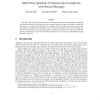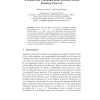CORR
2008
Springer
14 years 9 months ago
2008
Springer
The goal of this paper is to show why the framework of communication complexity seems suitable for the study of cellular automata. Researchers have tackled different algorithmic p...
COCOON
2008
Springer
14 years 9 months ago
2008
Springer
This paper describes a general quantum lower bounding technique for the communication complexity of a function that depends on the inputs given to two parties connected via paths,...
CIE
2008
Springer
14 years 9 months ago
2008
Springer
Abstract We prove, using a non-standard complexity assumption, that any language in NP has a 1-round (that is, the verifier sends a message to the prover, and the prover sends a me...
ICALP
2010
Springer
14 years 9 months ago
2010
Springer
We consider several questions inspired by the direct-sum problem in (two-party) communication complexity. In all questions, there are k fixed Boolean functions f1, . . . , fk and ...
EUROCRYPT
1997
Springer
14 years 11 months ago
1997
Springer
In this paper we present a new multi-authority secret-ballot election scheme that guarantees privacy, universal verifiability, and robustness. It is the first scheme for which the ...
CTRSA
2006
Springer
14 years 11 months ago
2006
Springer
In this work, we initiate the study of realizing a ranking functionality (m1,
CRYPTO
2006
Springer
14 years 11 months ago
2006
Springer
We present a robust multiparty computation protocol. The protocol is for the cryptographic model with open channels and a polytime adversary, and allows n parties to actively secur...
ATAL
2006
Springer
14 years 11 months ago
2006
Springer
It is self-evident that in numerous Multiagent settings, selfish agents stand to benefit from cooperating by forming coalitions. Nevertheless, negotiating a stable distribution of...
COCO
2009
Springer
14 years 11 months ago
2009
Springer
Abstract--We study the 2-party randomized communication complexity of read-once AC0 formulae. For balanced AND-OR trees T with n inputs and depth d, we show that the communication ...
COCO
2010
Springer
14 years 11 months ago
2010
Springer
Abstract—We consider two natural extensions of the communication complexity model that are inspired by distributed computing. In both models, two parties are equipped with synchr...





